Comparative Analysis of Seasonal Landsat 8 Images for Forest Aboveground Biomass Estimation in a Subtropical Forest
Abstract
1. Introduction
2. Materials and Methods
2.1. Study Area
2.2. Calculation of Plot-Level AGB
2.3. Remote Sensing Data and Information Extraction
2.4. Vegetation Classification Data
2.5. AGB Estimation Model
2.6. Model Comparison and Evaluation
3. Results
3.1. Comparison of AGB Estimates Using Seasonal Images of Total Vegetation
3.2. Comparison of AGB Estimates Using Seasonal Images of Different Forest Types
3.3. AGB Distribution Maps and Map Quality
4. Discussion
5. Conclusions
Author Contributions
Funding
Acknowledgments
Conflicts of Interest
References
- Houghton, R.A. Aboveground forest biomass and the global carbon balance. Glob. Chang. Biol. 2005, 11, 945–958. [Google Scholar] [CrossRef]
- Houghton, R.A.; Hall, F.; Goetz, S.J. Importance of biomass in the global carbon cycle. J. Geophys. Res. 2009, 114. [Google Scholar] [CrossRef]
- West, P.W. Tree and Forest Measurement, 2nd ed.; Springer: New York, NY, USA, 2009; ISBN 9783540959656. [Google Scholar]
- Vashum, K.T.; Jayakumar, S. Methods to Estimate Above-Ground Biomass and Carbon Stock in Natural Forests—A Review. J. Ecosyst. Ecogr. 2012. [Google Scholar] [CrossRef]
- Galidaki, G.; Zianis, D.; Gitas, I.; Radoglou, K.; Karathanassi, V.; Tsakiri–Strati, M.; Woodhouse, I.; Mallinis, G. Vegetation biomass estimation with remote sensing: Focus on forest and other wooded land over the Mediterranean ecosystem. Int. J. Remote Sens. 2017, 38, 1940–1966. [Google Scholar] [CrossRef]
- Lu, D.; Chen, Q.; Wang, G.; Liu, L.; Li, G.; Moran, E. A survey of remote sensing-based aboveground biomass estimation methods in forest ecosystems. Int. J. Digit. Earth 2014, 9, 63–105. [Google Scholar] [CrossRef]
- Rodríguez-veiga, P.; Wheeler, J.; Louis, V.; Tansey, K. Quantifying Forest Biomass Carbon Stocks from Space. Curr. For. Rep. 2017, 3, 1–18. [Google Scholar] [CrossRef]
- Kumar, L.; Sinha, P.; Taylor, S.; Alqurashi, A.F. Review of the use of remote sensing for biomass estimation to support renewable energy generation. J. Appl. Remote Sens. 2015, 9, 097696. [Google Scholar] [CrossRef]
- Cohen, W.B.; Goward, S.N. Landsat’s Role in Ecological Applications of Remote Sensing. Bioscience 2004, 54, 535–545. [Google Scholar] [CrossRef]
- Sun, H.; Qie, G.; Wang, G.; Tan, Y.; Li, J.; Peng, Y.; Ma, Z.; Luo, C. Increasing the accuracy of mapping urban forest carbon density by combining spatial modeling and spectral unmixing analysis. Remote Sens. 2015, 7, 15114–15139. [Google Scholar] [CrossRef]
- Roy, P.S.; Ravan, S.A. Biomass estimation using satellite remote sensing data—An investigation on possible approaches for natural forest. J. Biosci. 1996, 21, 535–561. [Google Scholar] [CrossRef]
- Safari, A.; Sohrabi, H. Ability of landsat-8 OLI derived texture metrics in estimating aboveground carbon stocks of coppice Oak Forests. Int. Arch. Photogramm. Remote Sens. Spat. Inf. Sci. 2016, XLI-B8, 751–754. [Google Scholar] [CrossRef]
- Zhao, Q.; Yu, S.; Zhao, F.; Tian, L.; Zhao, Z. Comparison of machine learning algorithms for forest parameter estimations and application for forest quality assessments. For. Ecol. Manag. 2019, 434, 224–234. [Google Scholar] [CrossRef]
- Ou, G.; Li, C.; Lv, Y.; Wei, A.; Xiong, H.; Xu, H.; Wang, G. Improving aboveground biomass estimation of Pinus densata forests in Yunnan using Landsat 8 imagery by incorporating age dummy variable and method comparison. Remote Sens. 2019, 11, 738. [Google Scholar] [CrossRef]
- Zhang, Y.; Li, F.; Liu, F. Forest biomass estimation based on remote sensing method for north Daxingan mountains. Adv. Mater. Res. 2011, 339, 336–341. [Google Scholar] [CrossRef]
- Yan, E.; Lin, H.; Wang, G.; Sun, H. Improvement of Forest Carbon Estimation by Integration of Regression Modeling and Spectral Unmixing of Landsat Data. IEEE Geosci. Remote Sens. Lett. 2015, 12, 2003–2007. [Google Scholar] [CrossRef]
- Fernández-Manso, O.; Fernández-Manso, A.; Quintano, C. Estimation of aboveground biomass in Mediterranean forestsby statistical modelling of ASTER fraction images. Int. J. Appl. Earth Obs. Geoinf. 2014, 31, 45–56. [Google Scholar] [CrossRef]
- Zhao, P.; Lu, D.; Wang, G.; Wu, C.; Huang, Y.; Yu, S. Examining spectral reflectance saturation in landsat imagery and corresponding solutions to improve forest aboveground biomass estimation. Remote Sens. 2016, 8, 469. [Google Scholar] [CrossRef]
- Shen, W.; Li, M.; Huang, C.; Wei, A. Quantifying Live Aboveground Biomass and Forest Disturbance of Mountainous Natural and Plantation Forests in Northern Guangdong, China, Based on Multi-Temporal Landsat, PALSAR and Field Plot Data. Remote Sens. 2016, 8, 595. [Google Scholar] [CrossRef]
- Tian, X.; Su, Z.; Chen, E.; Li, Z.; van der Tol, C.; Guo, J.; He, Q. Estimation of forest above-ground biomass using multi-parameter remote sensing data over a cold and arid area. Int. J. Appl. Earth Obs. Geoinf. 2012, 14, 160–168. [Google Scholar] [CrossRef]
- Wu, C.; Shen, H.; Shen, A.; Deng, J.; Gan, M.; Zhu, J.; Xu, H.; Wang, K. Comparison of machine-learning methods for above-ground biomass estimation based on Landsat imagery. J. Appl. Remote Sens. 2016, 10, 035010. [Google Scholar] [CrossRef]
- Blodgett, C.; Jakubauskas, M. Remote Sensing of Coniferous Forest Structure in Grand Teton National Park; University of Wyoming National Park Service Research Center: Laramie, WY, USA, 1995; Volume 19. [Google Scholar]
- Delissio, L.J.; Primack, R.B. The impact of drought on the population dynamics of canopy-tree seedlings in an aseasonal Malaysian rain forest. J. Trop. Ecol. 2003, 19, 489–500. [Google Scholar] [CrossRef]
- Rautiainen, M.; Heiskanen, J. Seasonal Dynamics of Boreal Forest Structure and Reflectance. In Proceedings of the AGU Fall Meeting, San Francisco, CA, USA, 13–17 December 2010. [Google Scholar]
- Zhu, X.; Liu, D. Improving forest aboveground biomass estimation using seasonal Landsat NDVI time-series. ISPRS J. Photogramm. Remote Sens. 2015, 102, 222–231. [Google Scholar] [CrossRef]
- Tian, X.; Li, Z.; Su, Z.; Chen, E.; van der Tol, C.; Li, X.; Guo, Y.; Li, L.; Ling, F. Estimating montane forest above-ground biomass in the upper reaches of the Heihe River Basin using Landsat-TM data. Int. J. Remote Sens. 2014, 35, 7339–7362. [Google Scholar] [CrossRef]
- Zhu, J.; Huang, Z.; Sun, H.; Wang, G. Mapping forest ecosystem biomass density for Xiangjiang River Basin by combining plot and remote sensing data and comparing spatial extrapolation methods. Remote Sens. 2017, 9, 241. [Google Scholar] [CrossRef]
- Shao, Z.; Zhang, L. Estimating forest aboveground biomass by combining optical and SAR data: A case study in genhe, inner Mongolia, China. Sensors 2016, 16, 834. [Google Scholar] [CrossRef]
- Mutanga, O.; Adam, E.; Cho, M.A. High density biomass estimation for wetland vegetation using worldview-2 imagery and random forest regression algorithm. Int. J. Appl. Earth Obs. Geoinf. 2012, 18, 399–406. [Google Scholar] [CrossRef]
- Huete, A.; Didan, K.; Miura, T.; Rodriguez, E.P.; Gao, X.; Ferreira, L.G. Overview of the radiometric and biophysical performance of the MODIS vegetation indices. Remote Sens. Environ. 2002, 83, 195–213. [Google Scholar] [CrossRef]
- Safari, A.; Sohrabi, H.; Powell, S.; Shataee, S. A comparative assessment of multi-temporal Landsat 8 and machine learning algorithms for estimating aboveground carbon stock in coppice oak forests. Int. J. Remote Sens. 2017, 38, 6407–6432. [Google Scholar] [CrossRef]
- Scott, L.; Powell; Cohen, W.B.; Healey, S.P.; Kennedy, R.E.; Moisen, G.G.; Pierce, K.B.; Ohmann, J.L. Quantification of live aboveground forest biomass dynamics with Landsat time-series and field inventory data: A comparison of empirical modeling approaches. Remote Sens. Environ. 2010, 114, 1053–1068. [Google Scholar] [CrossRef]
- Chen, A.; He, X.; Guan, H.; Cai, Y. Trends and periodicity of daily temperature and precipitation extremes during 1960–2013 in Hunan Province, central south China. Theor. Appl. Climatol. 2018, 132, 71–88. [Google Scholar] [CrossRef]
- Li, W.; Li, F. Research of Forest Resources in China, 1st ed.; China Forestry Publishing House: Beijing, China, 1996; ISBN 7503817224. [Google Scholar]
- Li, H.; Lei, Y.; Zeng, W.; Chen, Y.; Huang, G. Estimation and Evaluation of Forestry Biomass Carbon Storage in China; China Forestry Press: Beijing, China, 2010. [Google Scholar]
- Vermote, E.; Justice, C.; Claverie, M.; Franch, B. Preliminary analysis of the performance of the Landsat 8/OLI land surface reflectance product. Remote Sens. Environ. 2016, 185, 46–56. [Google Scholar] [CrossRef]
- Rouse, W.; Haas, R.H.; Deering, D.W. Monitoring vegetation systems in the Great Plains with ERTS, NASA SP-351. In Third ERTS-1 Symposium; NASA: Washington, DC, USA, 1974; Volume 1, pp. 309–317. [Google Scholar]
- Lu, D.; Mausel, P.; Brondízio, E.; Moran, E. Relationships between forest stand parameters and Landsat TM spectral responses in the Brazilian Amazon Basin. For. Ecol. Manag. 2004, 198, 149–167. [Google Scholar] [CrossRef]
- Nemani, R.; Pierce, L.; Running, S.; Band, L. Forest ecosystem processes at the watershed scale: Sensitivity to remotely-sensed leaf area index estimates. Int. J. Remote Sens. 1993, 14, 2519–2534. [Google Scholar] [CrossRef]
- Clevers, J.G.P.W. The derivation of a simplified reflectance model for the estimation of leaf area index. Remote Sens. Environ. 1988, 25, 53–69. [Google Scholar] [CrossRef]
- Wu, W. The Generalized Difference Vegetation Index (GDVI) for dryland characterization. Remote Sens. 2014, 6, 1211–1233. [Google Scholar] [CrossRef]
- Ünsalan, C.; Boyer, K.L. Linearized vegetation indices based on a formal statistical framework. IEEE Trans. Geosci. Remote Sens. 2004, 42, 1575–1585. [Google Scholar] [CrossRef]
- Gao, B.-C. NDWI-A Normalized Difference Water Index for Remote Sensing of Vegetation Liquid Water from Space. Remote Sens. Environ. 1996, 58, 257–266. [Google Scholar] [CrossRef]
- Gitelson, A.A.; Merzlyak, M.N. Remote sensing of chlorophyll concentration in higher plant leaves. Adv. Space Res. 1998, 22, 689–692. [Google Scholar] [CrossRef]
- HUETE, A.R. A Soil-Adjusted Vegetation Index (SAVI). Remote Sens. Environ. 1988, 25, 295–309. [Google Scholar] [CrossRef]
- Birth, G.S.; McVey, G.R. Measuring the Color of Growing Turf with a Reflectance Spectrophotometer 1. Agron. J. 1968, 60, 640–643. [Google Scholar] [CrossRef]
- Lu, D.; Batistella, M. Exploring TM image texture and its relationships with biomass estimation in Rondônia, Brazilian Amazon. Acta Amaz. 2005, 35, 249–257. [Google Scholar] [CrossRef]
- Bontemps, S.; Defourny, P.; Radoux, J.; Van Bogaert, E.; Lamarche, C.; Achard, F.; Mayaux, P.; Boettcher, M.; Brockmann, C.; Kirches, G.; et al. Consistent Global Land Cover Maps for Climate Modeling Communities: Current Achievements of the ESA’s Land Cover CCI. In Proceedings of the ESA Living Planet Symposium, Edinburgh, UK, 9–13 September 2013; pp. 9–13. [Google Scholar]
- Liu, X.; Yu, L.; Li, W.; Peng, D.; Zhong, L.; Li, L.; Xin, Q.; Lu, H.; Yu, C.; Gong, P. Comparison of country-level cropland areas between ESA-CCI land cover maps and FAOSTAT data. Int. J. Remote Sens. 2018, 39, 6631–6645. [Google Scholar] [CrossRef]
- Gómez, R.S.; Pérez, J.G.; Del, M.; López, M. Collinearity diagnostic applied in ridge estimation through the variance inflation factor. J. Appl. Stat. 2016, 43, 1831–1849. [Google Scholar] [CrossRef]
- Brien, R.M.O. A Caution Regarding Rules of Thumb for Variance Inflation Factors. Qual. Quant. 2007, 41, 673–690. [Google Scholar] [CrossRef]
- Burman, B.Y.P. A comparative study of ordinary cross-validation, r-fold cross-validation and the repeated learning-testing methods. Biometrika 1989, 76, 503–514. [Google Scholar] [CrossRef]
- Freeman, E.A.; Moisen, G.G.; Coulston, J.W.; Wilson, B.T. Random forests and stochastic gradient boosting for predicting tree canopy cover: Comparing tuning processes and model performance. Can. J. For. Res. 2015, 46, 323–339. [Google Scholar] [CrossRef]
- Fassnacht, F.E.; Hartig, F.; Latifi, H.; Berger, C.; Hernández, J.; Corvalán, P.; Koch, B. Importance of sample size, data type and prediction method for remote sensing-based estimations of aboveground forest biomass. Remote Sens. Environ. 2014, 154, 102–114. [Google Scholar] [CrossRef]
- White, J.C.; Gómez, C.; Wulder, M.A.; Coops, N.C. Characterizing temperate forest structural and spectral diversity with Hyperion EO-1 data. Remote Sens. Environ. 2010, 114, 1576–1589. [Google Scholar] [CrossRef]
- Singh, M.; Malhi, Y.; Bhagwat, S. Biomass estimation of mixed forest landscape using a Fourier transform texture-based approach on very-high-resolution optical satellite imagery. Int. J. Remote Sens. 2014, 35, 3331–3349. [Google Scholar] [CrossRef]
- Wang, X.; Shao, G.; Chen, H.; Lewis, B.J.; Qi, G.; Yu, D.; Zhou, L.; Dai, L. An application of remote sensing data in mapping landscape-level forest biomass for monitoring the effectiveness of forest policies in northeastern china. Environ. Manag. 2013, 52, 612–620. [Google Scholar] [CrossRef]
- Li, C.; Li, Y.; Li, M. Improving forest aboveground biomass (AGB) estimation by incorporating crown density and using Landsat 8 OLI images of a subtropical forest in western Hunan in central China. Forests 2019, 10, 104. [Google Scholar] [CrossRef]
- Gao, Y.; Lu, D.; Li, G.; Wang, G.; Chen, Q.; Liu, L.; Li, D. Comparative analysis of modeling algorithms for forest aboveground biomass estimation in a subtropical region. Remote Sens. 2018, 10, 627. [Google Scholar] [CrossRef]
- Chrysafis, I.; Mallinis, G.; Gitas, I.; Tsakiri-Strati, M. Estimating Mediterranean forest parameters using multi seasonal Landsat 8 OLI imagery and an ensemble learning method. Remote Sens. Environ. 2017, 199, 154–166. [Google Scholar] [CrossRef]
- Lu, D. Aboveground biomass estimation using Landsat TM data in the Brazilian Amazon. Int. J. Remote Sens. 2005, 26, 2509–2525. [Google Scholar] [CrossRef]
- Bonate, P.L. Pharmacokinetic-Pharmacodynamic Modeling and Simulation; Springer: New York, NY, USA, 2011; ISBN 9781441994844. [Google Scholar]
- Lu, D. The potential and challenge of remote sensing-based biomass estimation. Int. J. Remote Sens. 2006, 27, 1297–1328. [Google Scholar] [CrossRef]
- Main-Knorn, M.; Moisen, G.G.; Healey, S.P.; Keeton, W.S.; Freeman, E.A.; Hostert, P. Evaluating the remote sensing and inventory-based estimation of biomass in the western carpathians. Remote Sens. 2011, 3, 1427–1446. [Google Scholar] [CrossRef]
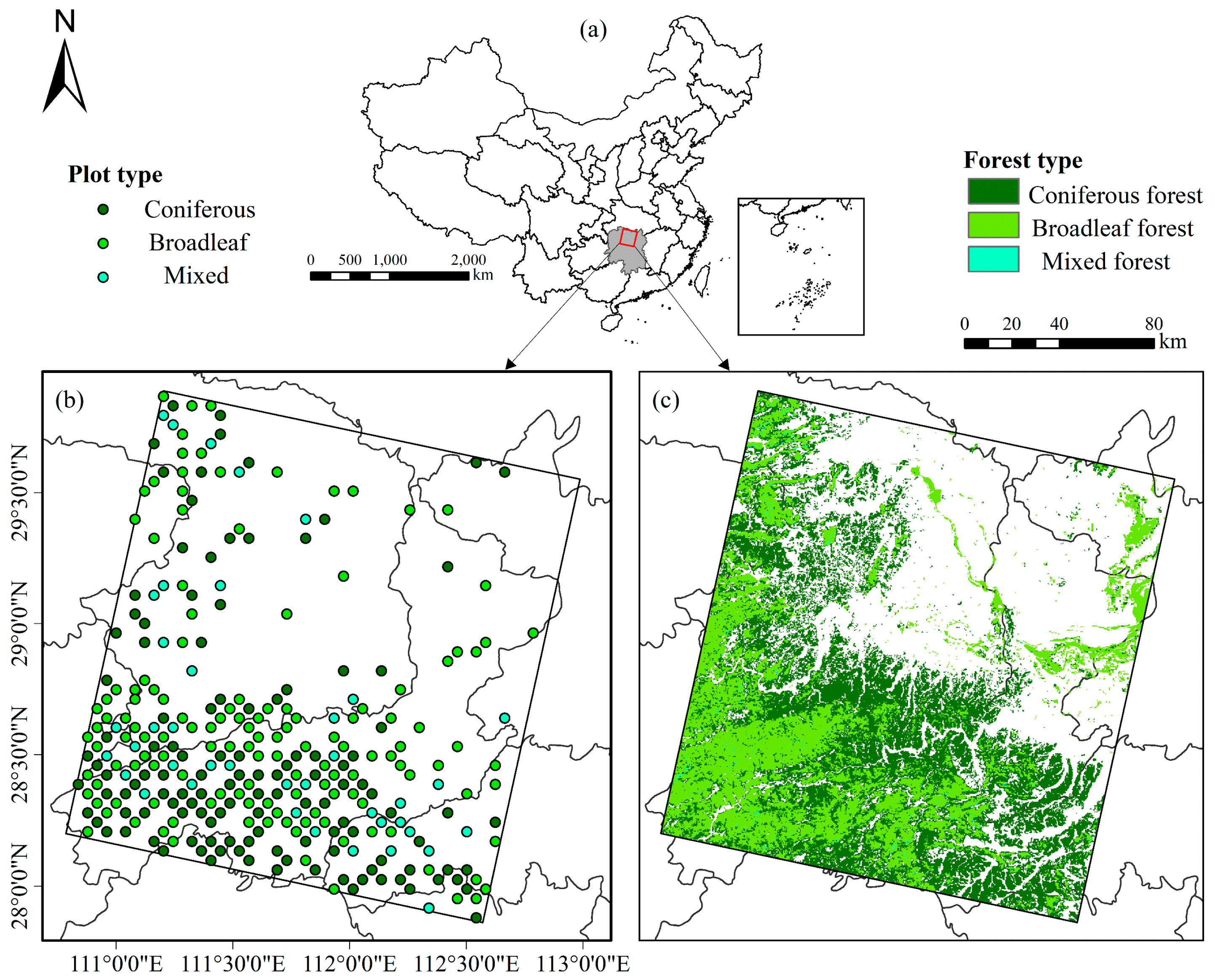

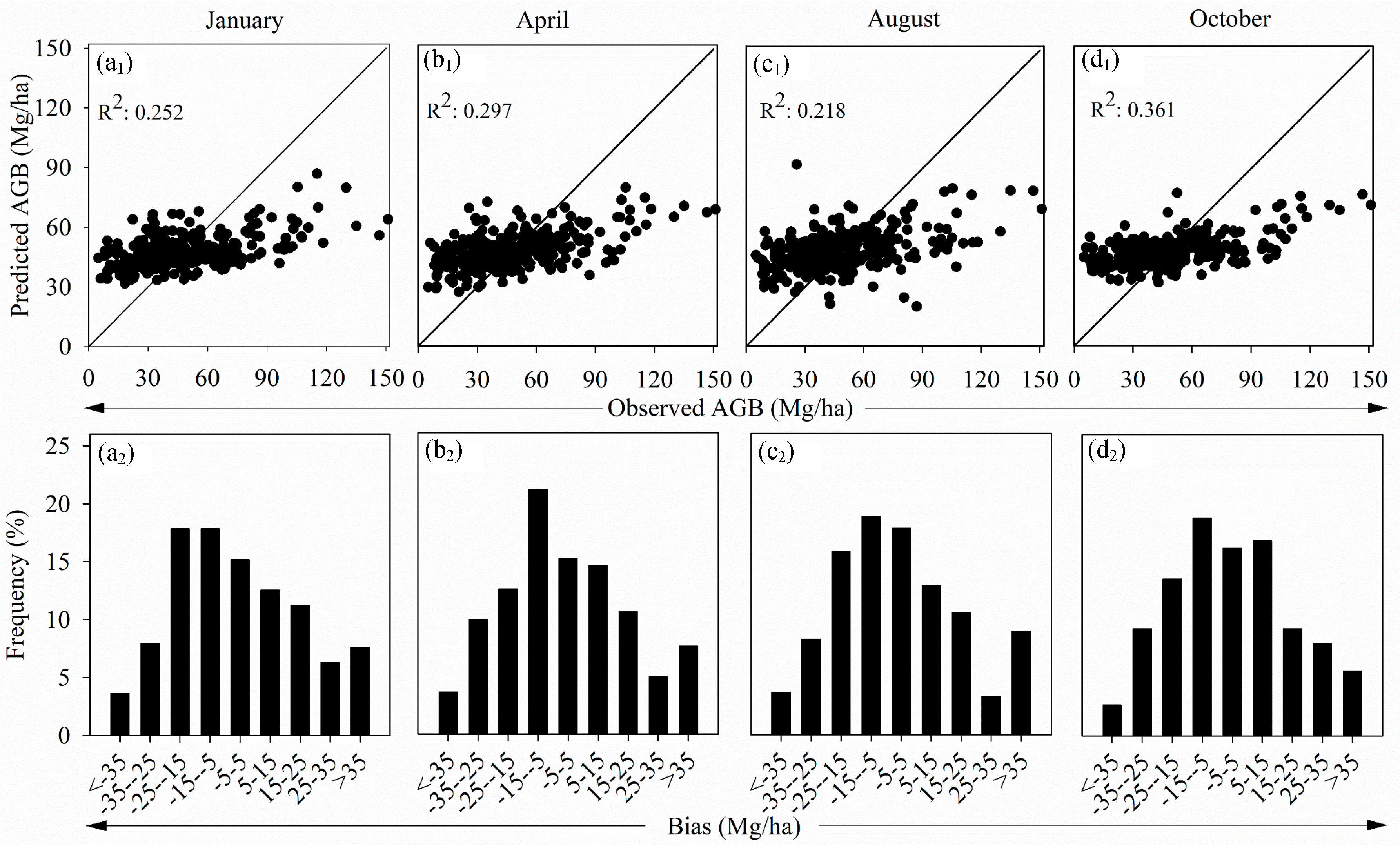
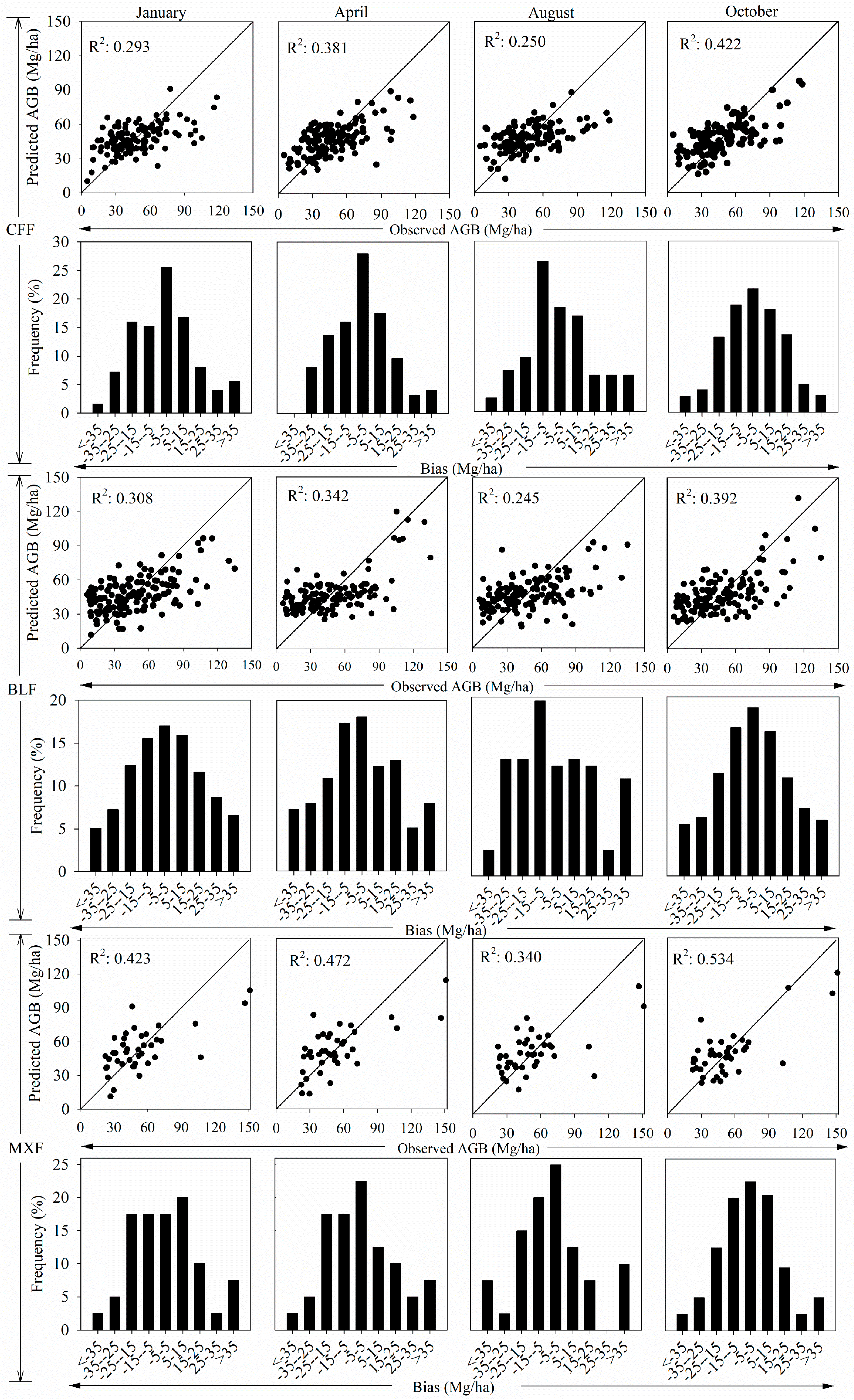
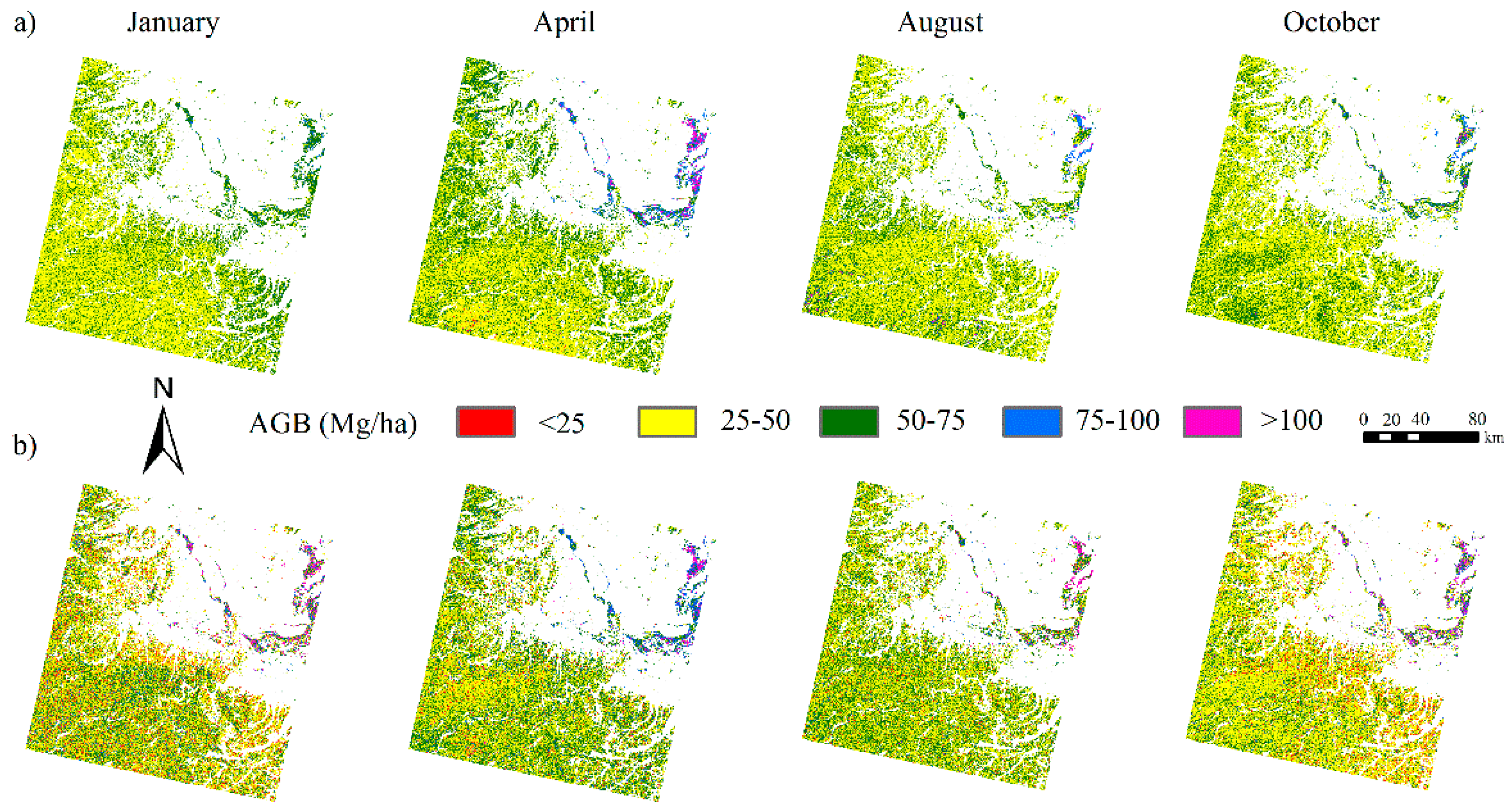
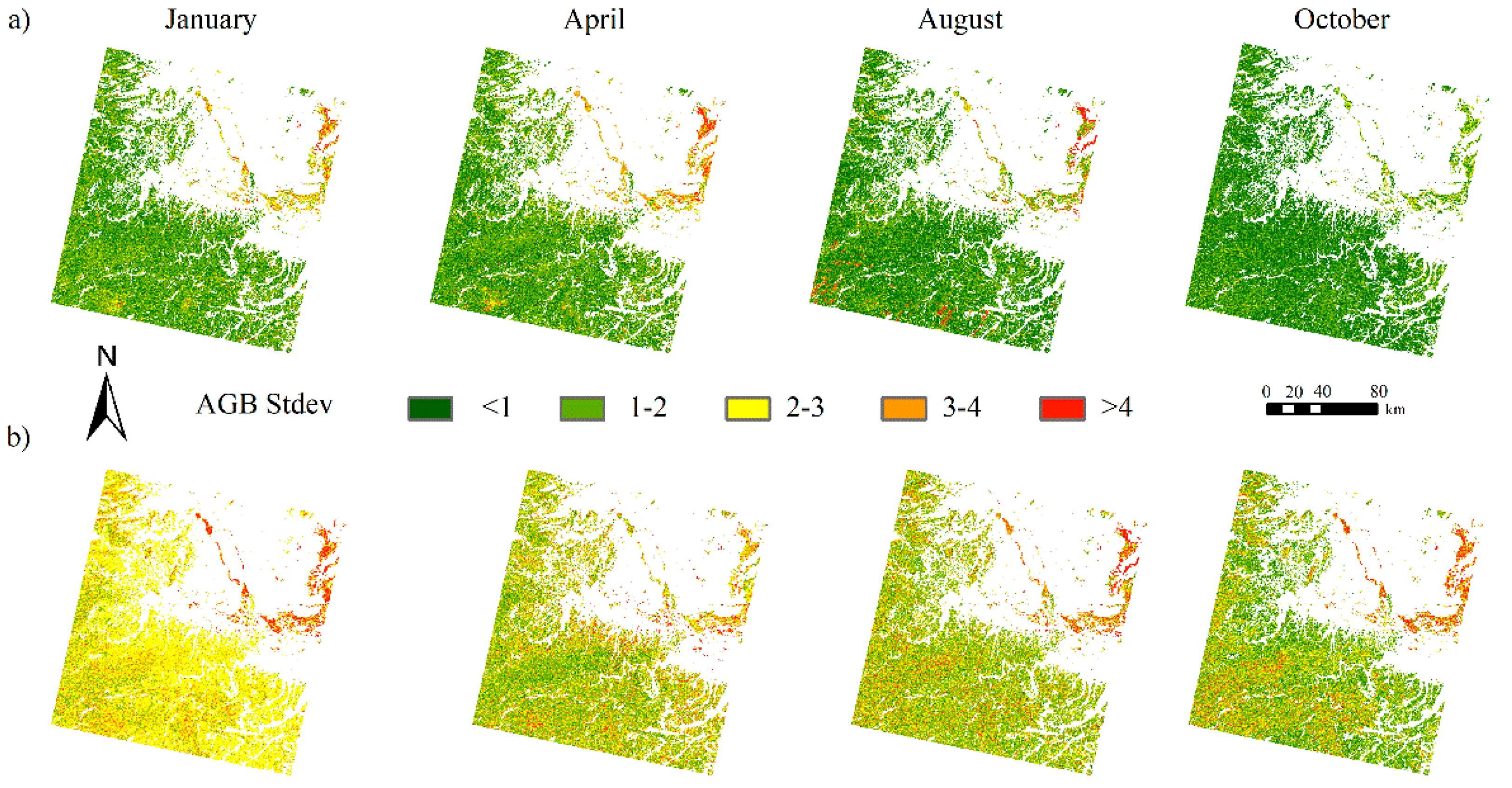
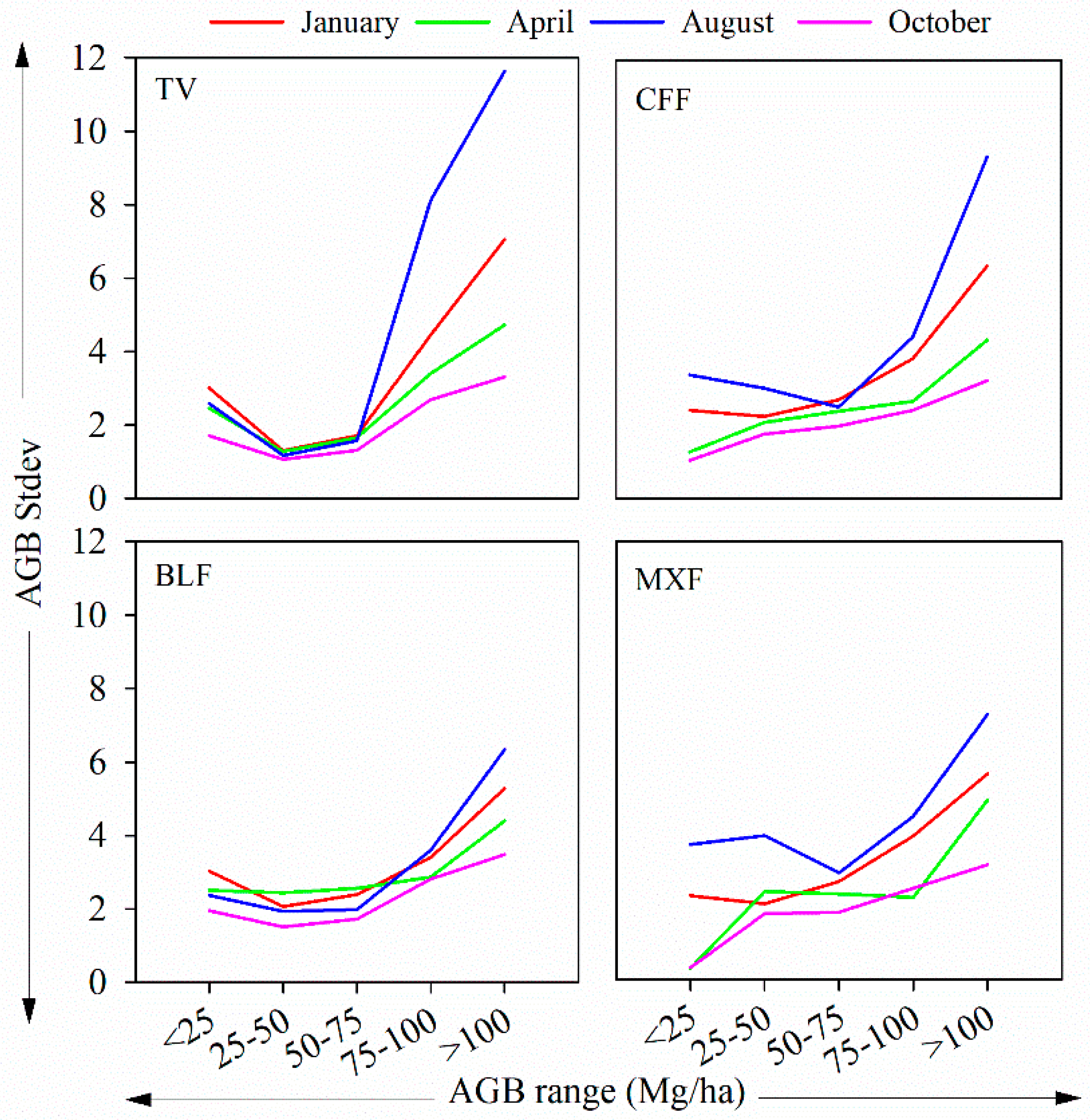
| Forest Type | No. of Sample Plots | Minimum (Mg/ha) | Mean (Mg/ha) | Maximum (Mg/ha) | Standard Deviation |
|---|---|---|---|---|---|
| CFF | 125 | 5.01 | 47.63 | 118.33 | 22.89 |
| BLF | 138 | 6.08 | 47.58 | 135.08 | 28.12 |
| MXF | 40 | 22.33 | 52.69 | 151.06 | 29.45 |
| TV | 303 | 5.01 | 48.27 | 151.06 | 26.24 |
| Remote Sensing Data | Month | Acquisition Date | Cloud Cover (%) | Image Type |
|---|---|---|---|---|
| Landsat 8 OLI (124/40) | January | 14 January 2014 | 0.04 | L1TP |
| April | 4 April 2014 | 0.01 | L1TP | |
| August | 7 August 2013 | 0.61 | L1TP | |
| October | 10 October 2013 | 0.17 | L1TP |
| Predictor Variable | Formula | Reference |
|---|---|---|
| Landsat 8 OLI original bands 2–7 | [31] | |
| Normalized Difference Vegetation Index (NDVI) | (NIR − R)/(NIR + R) | [37] |
| Atmospherically Resistant Vegetation Index (ARVI) | (NIR − 2R + B)/(NIR + 2R − B) | [38] |
| Corrected Normalized Difference Vegetation Index (CNDVI) | NDVI * (1 − (SWIR1 − SWIRmin)/(SWIRmax − SWIRmin)) | [39] |
| Difference Vegetation Index (DVI) | NIR − R | [40] |
| Enhanced Vegetation Index (EVI) | (NIR − R)/(NIR + R + B) | [30] |
| Generalized Difference Vegetation Index (GDVI) | (NIR2 − R2)/(NIR2 + R2) | [41] |
| Linearized NDVI (LNDVI) | 4/π * arctan (NDVI) | [42] |
| Normalized Difference Water Index (NDWI) | (NIR − SWIR2)/(NIR + SWIR2) | [43] |
| Normalized Green Difference Vegetation Index (NGDI) | (NIR − G)/(NIR + G) | [44] |
| Red-green Vegetation Index (RGVI) | (R − G)/(R + G) | [10] |
| Soil-adjusted Vegetation Index (SAVI) | (1 + L) * (NIR − R)/(NIR + R + L) | [45] |
| Simple Ratio (SR) | NIR/R | [46] |
| Principal Component Analysis (PCA) The first three PCs from principal component analysis | [6] | |
| Texture (window sizes: 3 × 3, 5 × 5, 7 × 7 pixels) Contrast, Correlation, Dissimilarity, Entropy, Homogeneity, Angular second moment, Mean, and Variance | [47] | |
| Month | Selected Variables for Total Vegetation |
|---|---|
| January | b6_EN3Jan, b3_EN3Jan, b2_EN3Jan, b5_Jan |
| April | b7_SEM3Apr, b5_Apr, b2_VA7Apr, NDWI_Apr |
| August | b6_COR5Aug, b4_COR7Aug, b5_SEM7Aug, b5_HO7Aug, b2_CON5Aug, b4_SEM5Aug |
| October | b5_SEM5Oct, b4_CON7Oct, SR Oct, b6_COR3Oct |
| Month | R2 | RMSE (Mg/ha) | RMSE % | Bias (Mg/ha) |
|---|---|---|---|---|
| January | 0.31 | 21.90 | 44.8 | 1.08 |
| April | 0.34 | 21.95 | 45.0 | 0.81 |
| August | 0.27 | 22.15 | 45.7 | 0.54 |
| October | 0.39 | 21.67 | 44.1 | −0.19 |
| Month | RMSE (Mg/ha) | RMSE% | ||||
|---|---|---|---|---|---|---|
| CFF | BLF | MXF | CFF | BLF | MXF | |
| January | 20.72 | 23.14 | 26.96 | 42.70 | 47.42 | 53.67 |
| April | 19.65 | 22.60 | 21.06 | 41.04 | 48.07 | 38.10 |
| August | 18.50 | 24.26 | 27.68 | 39.32 | 50.25 | 54.12 |
| October | 18.02 | 22.69 | 23.47 | 37.58 | 47.31 | 41.99 |
| Month | Selected Variables for Different Forest Types | ||
|---|---|---|---|
| CFF | BLF | MXF | |
| January | b3_VA7Jan, b4_HO5Jan, b2_COR7Jan, DVI_Jan, b4_CON3Jan | b5_SEM5Jan, b7_EN3Jan, b6_SEM3Jan, b3_EN3Jan b6_SEM5Jan, b7_SEM7Jan, | b3_COR3Jan, b6_EN3Jan, b6_SEM7Jan, b6_CON3Jan, b5_COR5Jan |
| April | b2_VA3Apr, b2_VA5Apr, b2_HO7Apr, b5_EN5Apr, b6_SEM7Apr | b7_SEM3Apr, b2_ME7Apr SR_Apr, b6_ME5Apr, b2_CON5Apr, b2_EN7Apr | b6_COR3Apr, b7_VA3Apr, b2_HO3Apr, b5_COR3Apr, b5_COR7Apr |
| August | b6_COR5Aug, b5_DI5Aug, b5_DI7Aug, b4_COR3Aug, b7_SEM5Aug, b6_HO5Aug | b6_COR5Aug, b5_HO5Aug, b5_SEM5Aug, b5_HO3Aug, b5_EN3Aug, b6_COR3Aug | b4_VA3Aug, b7_EN3Aug, b7_COR3Aug, b3_SEM7Aug, b6_HO3Aug |
| October | b6_COR3Oct, SR_Oct b7_COR3Oct, b3_ME7Oct b6_SEM3Oct, b6_EN3Oct | b5_SEM3Oct, PCA3_Oct, b4_CON7Oct, b7_ME7Oct, b2_SEM7Oct, b5_EN3Oct | b6_VA5Oct, b6_VA7Oct, b5_EN3Oct, b5_COR3Oct, b6_SEM3Oct |
| Month | Forest Types | Accuracy Indicators | |||
|---|---|---|---|---|---|
| R2 | RMSE (Mg/ha) | RMSE% | Bias (Mg/ha) | ||
| January | CFF | 0.35 | 18.53 | 39.07 | 0.12 |
| BLF | 0.38 | 21.89 | 45.65 | −0.26 | |
| MXF | 0.48 | 20.82 | 39.52 | −0.003 | |
| April | CFF | 0.43 | 17.40 | 35.97 | 0.22 |
| BLF | 0.45 | 21.18 | 44.35 | −0.09 | |
| MXF | 0.52 | 20.16 | 38.26 | −0.003 | |
| August | CFF | 0.31 | 19.33 | 40.10 | −0.18 |
| BLF | 0.33 | 23.03 | 47.38 | −0.10 | |
| MXF | 0.35 | 23.37 | 44.36 | −0.36 | |
| October | CFF | 0.47 | 17.23 | 35.95 | 0.04 |
| BLF | 0.46 | 21.34 | 44.38 | −0.02 | |
| MXF | 0.55 | 19.45 | 36.92 | −0.0001 | |
© 2019 by the authors. Licensee MDPI, Basel, Switzerland. This article is an open access article distributed under the terms and conditions of the Creative Commons Attribution (CC BY) license (http://creativecommons.org/licenses/by/4.0/).
Share and Cite
Li, C.; Li, M.; Liu, J.; Li, Y.; Dai, Q. Comparative Analysis of Seasonal Landsat 8 Images for Forest Aboveground Biomass Estimation in a Subtropical Forest. Forests 2020, 11, 45. https://doi.org/10.3390/f11010045
Li C, Li M, Liu J, Li Y, Dai Q. Comparative Analysis of Seasonal Landsat 8 Images for Forest Aboveground Biomass Estimation in a Subtropical Forest. Forests. 2020; 11(1):45. https://doi.org/10.3390/f11010045
Chicago/Turabian StyleLi, Chao, Mingyang Li, Jie Liu, Yingchang Li, and Qianshi Dai. 2020. "Comparative Analysis of Seasonal Landsat 8 Images for Forest Aboveground Biomass Estimation in a Subtropical Forest" Forests 11, no. 1: 45. https://doi.org/10.3390/f11010045
APA StyleLi, C., Li, M., Liu, J., Li, Y., & Dai, Q. (2020). Comparative Analysis of Seasonal Landsat 8 Images for Forest Aboveground Biomass Estimation in a Subtropical Forest. Forests, 11(1), 45. https://doi.org/10.3390/f11010045





